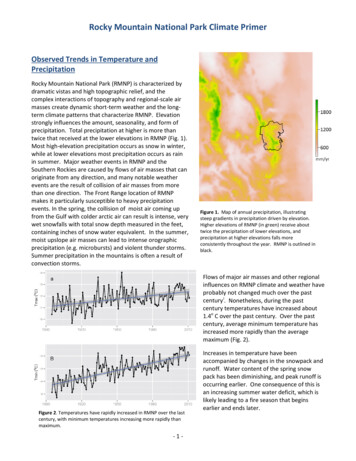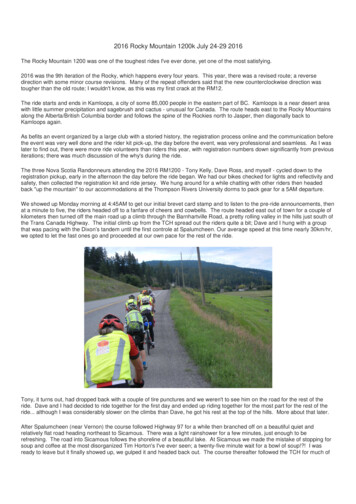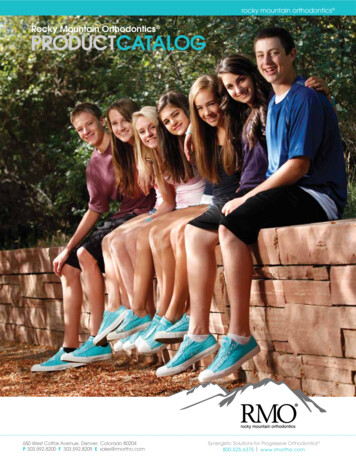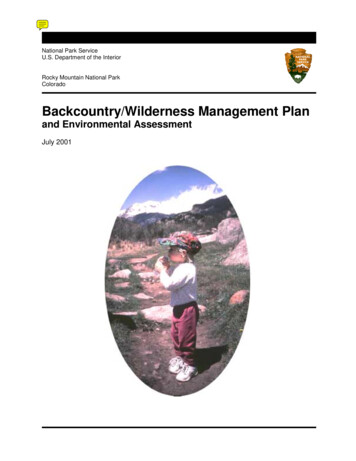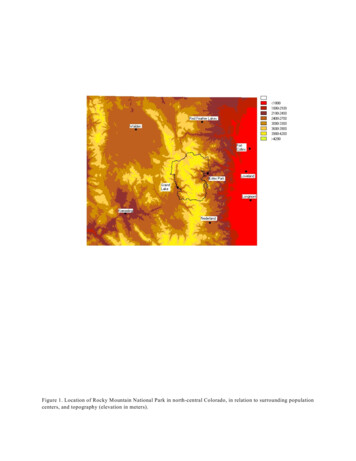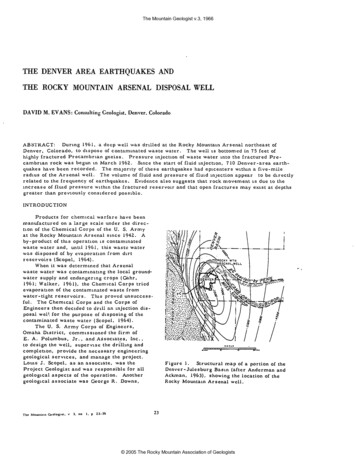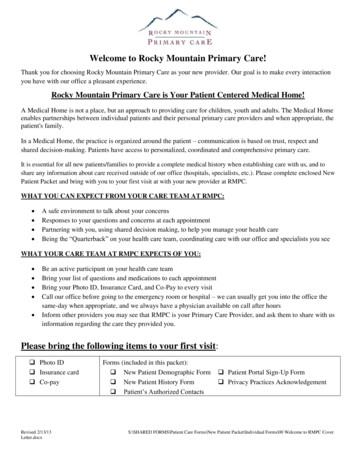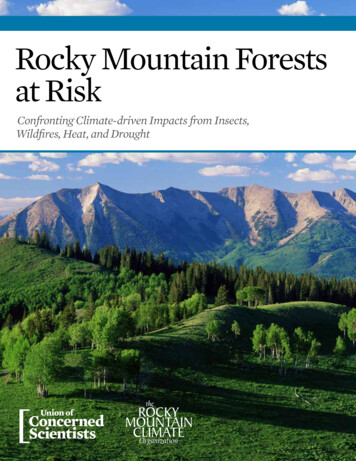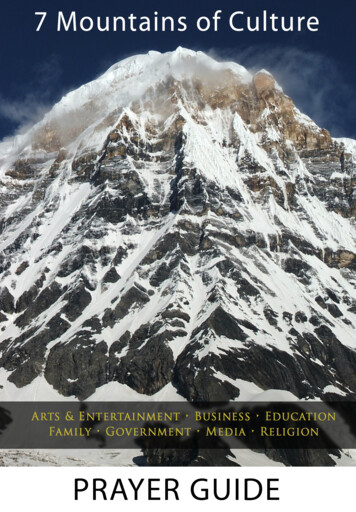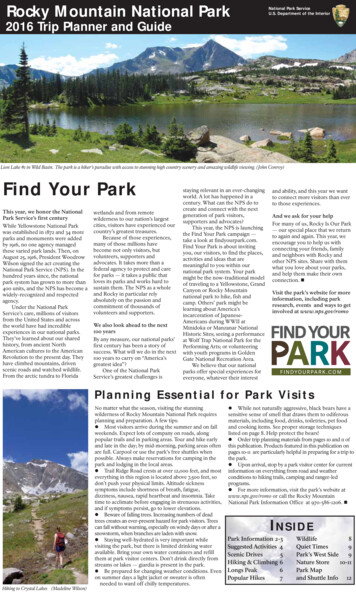
Transcription
Rocky Mountain National ParkNational Park ServiceU.S. Department of the Interior2016 Trip Planner and GuideLion Lake #1 in Wild Basin. The park is a hiker’s paradise with access to stunning high country scenery and amazing wildlife viewing. (John Conroy)Find Your ParkThis year, we honor the NationalPark Service’s first centuryWhile Yellowstone National Parkwas established in 1872 and 34 moreparks and monuments were addedby 1916, no one agency managedthese varied park lands. Then, onAugust 25, 1916, President WoodrowWilson signed the act creating theNational Park Service (NPS). In thehundred years since, the nationalpark system has grown to more than400 units, and the NPS has become awidely-recognized and respectedagency.Under the National ParkService’s care, millions of visitorsfrom the United States and acrossthe world have had incredibleexperiences in our national parks.They’ve learned about our sharedhistory, from ancient NorthAmerican cultures to the AmericanRevolution to the present day. Theyhave climbed mountains, drivenscenic roads and watched wildlife.From the arctic tundra to Floridawetlands and from remotewilderness to our nation’s largestcities, visitors have experienced ourcountry’s greatest treasures.Because of those experiences,many of those millions havebecome not only visitors, butvolunteers, supporters andadvocates. It takes more than afederal agency to protect and carefor parks — it takes a public thatloves its parks and works hard tosustain them. The NPS as a wholeand Rocky in particular relyabsolutely on the passion andcommitment of thousands ofvolunteers and supporters.We also look ahead to the next100 yearsBy any measure, our national parks’first century has been a story ofsuccess. What will we do in the next100 years to carry on “America’sgreatest idea”?One of the National ParkService’s greatest challenges isstaying relevant in an ever-changingworld. A lot has happened in acentury. What can the NPS do tocreate and connect with the nextgeneration of park visitors,supporters and advocates?This year, the NPS is launchingthe Find Your Park campaign —take a look at findyourpark.com.Find Your Park is about invitingyou, our visitors, to find the places,activities and ideas that aremeaningful to you within ournational park system. Your parkmight be the now-traditional modelof traveling to a Yellowstone, GrandCanyon or Rocky Mountainnational park to hike, fish andcamp. Others’ park might belearning about America’sincarceration of JapaneseAmericans during WWII atMinidoka or Manzanar NationalHistoric Sites; seeing a performanceat Wolf Trap National Park for thePerforming Arts; or volunteeringwith youth programs in GoldenGate National Recreation Area.We believe that our nationalparks offer special experiences foreveryone, whatever their interestand ability, and this year we wantto connect more visitors than everto those experiences.And we ask for your helpFor many of us, Rocky Is Our Park— our special place that we returnto again and again. This year, weencourage you to help us withconnecting your friends, familyand neighbors with Rocky andother NPS sites. Share with themwhat you love about your parks,and help them make their ownconnection. nVisit the park’s website for moreinformation, including parkresearch, events and ways to getinvolved at www.nps.gov/romoPlanning Essential for Park VisitsHiking to Crystal Lakes (Madeline Wilson)No matter what the season, visiting the stunningwilderness of Rocky Mountain National Park requiresplanning and preparation. A few tips:l Most visitors arrive during the summer and on fallweekends. Expect lots of company on roads, alongpopular trails and in parking areas. Tour and hike earlyand late in the day; by mid-morning, parking areas oftenare full. Carpool or use the park’s free shuttles whenpossible. Always make reservations for camping in thepark and lodging in the local areas.l Trail Ridge Road crests at over 12,000 feet, and mosteverything in this region is located above 7,500 feet, sodon’t push your physical limits. Altitude sicknesssymptoms include shortness of breath, fatigue,dizziness, nausea, rapid heartbeat and insomnia. Taketime to acclimate before engaging in strenuous activities,and if symptoms persist, go to lower elevations.l Beware of falling trees. Increasing numbers of deadtrees creates an ever-present hazard for park visitors. Treescan fall without warning, especially on windy days or after asnowstorm, when branches are laden with snow.l Staying well-hydrated is very important whilevisiting the park, but there is limited drinking wateravailable. Bring your own water containers and refillthem at park visitor centers. Don’t drink directly fromstreams or lakes — giardia is present in the park.l Be prepared for changing weather conditions. Evenon summer days a light jacket or sweater is oftenneeded to ward off chilly temperatures.l While not naturally aggressive, black bears have asensitive sense of smell that draws them to odiferousmaterials, including food, drinks, toiletries, pet foodand cooking items. See proper storage techniqueslisted on page 8. Help protect the bears!l Order trip planning materials from pages 10 and 11 ofthis publication. Products featured in this publication onpages 10-11 are particularly helpful in preparing for a trip tothe park.l Upon arrival, stop by a park visitor center for currentinformation on everything from road and weatherconditions to hiking trails, camping and ranger-ledprograms.l For more information, visit the park’s website atwww.nps.gov/romo or call the Rocky MountainNational Park Information Office at 970-586-1206. nI NSIDEPark Information 2-3Suggested Activities 4Scenic Drives5Hiking & Climbing 6Longs Peak6Popular Hikes7Wildlife8Quiet Times9Park’s West Side9Nature Store10-11Park Mapand Shuttle Info 12
Park InformationThe Park isAlways OpenRocky Mountain National Park isopen 24 hours a day year-round.Visitors can enter or exit any time.Summer is the busiest time of year.Visitor center hours vary seasonally.Some park facilities and roads areclosed during the winter months,including much of Trail Ridge Roadand Old Fall River Road. If visitorsintend to stay overnight, they mustbe in a designated campground siteor a backcountry campsite reservedby a valid permit. Moraine Parkcampground is open in winter.There is no overnight lodging in thepark; see neighboring communitiesfor local options.Be PreparedRocky Mountain National Parkweather can be changeable andsometimes extreme. As elevation isgained, temperatures drop andprecipitation increases, so be preparedfor chilly conditions – especially athigher altitudes – year-round. Bringappropriate footwear and clothing foreach season, including rainwear forsummer storms and winter geardesigned to protect against extremecold and wind. Layers of insulating,windproof clothing like synthetic orwool are recommended at all times ofyear, especially for higher elevations.Temperatures, precipitation, andconditions can vary year to year, andsometimes the seasons blur together– it can snow on the mountains anymonth of the year!Summer(mid-June — early September)Sunny mornings, afternoonthunderstorms often with dangerouslightning, and clear, cool nightstypify this glorious mountain season.This is the busiest time of year in thepark, when visitors enjoy wildflowersand possible wildlife sightings. Mostpark facilities typically are open.Autumn(mid-September — November)In general, autumn comes early to thehigh country. Days often start withclear, frosty mornings and bright blueskies, and end with chilly nights.Snowstorms are possible, and TrailRidge Road can temporarily close dueto snow. Trail Ridge usually closes forthe season by mid- to late-October.The elk rut is at its height from midSeptember through mid-October.Aspens usually turn golden in theGrand Lake area in early September.On the east side, autumn colorscommonly start at Bear Lake in midSeptember and in the Estes Park areain late September. Temperature, rain,snow and wind can affect the treesand cause the leaves to fall early.Wintersome park roads and facilities areclosed, this is a quieter time throughout the park and often a good time toview wildlife. Snowshoeing andcross-country and backcountry skiingare popular activities on both the eastand the west sides of the park.Spring(April — mid-June)Spring weather in the park is veryunpredictable. March and April aretypically the snowiest months on theeast side, with snows often occurringin May and even early June. Springsnows tend to be much wetter.However, warm, dry, sunny springdays when the first flowers bloomand plows are working to clear theupper reaches of Trail Ridge Roadare also enjoyable.Be InformedTrail Ridge Road Status (open orclosed) – recorded message on thecurrent road status, 970-586-1222Colorado Department ofTransportation Road Conditions877-315-7623 or www.cotrip.orgRanger-led ProgramsA wide range of ranger-led walks,talks and evening programs is offeredthroughout the summer. In winter,ski and snowshoe treks are availableby reservation. Programs are listed inthe official park newspaper. For moreinformation, call 970-586-1206 orvisit tions of trout species,including brown, brook, rainbow andcutthroat, are found in the park.Fishing is permitted indesignated park waters. A validColorado license is required for allpersons 16 years of age and older.Annual, five-day and one-dayresident and non-resident licenses aresold in neighboring communities.Some lakes and streams areclosed to fishing to protectthreatened native species. Otherareas are catch-and-release only, withspecial regulations in place. Detailedinformation, including license fees,open and closed waters, methods ofcapture and limits on size andpossession, is available at park visitorcenters, ranger stations and online athttp://go.nps.gov/RockyFishingHorseback RidingSeveral stables are located in andaround the park, offering guidedrides along park trails. For a list ofprivate companies contracted toconduct horseback rides in the parkvisit http://go.nps.gov/RockyHorsesPrivate stock, including horses,mules, ponies, llamas, and burros, isallowed on miles of park trails;visit http://go.nps.gov/RockyHorses(December — March)Conditions can range considerablythis time of year. Lower elevationson the east side of the park can bewindy, cool and snow-free, whilehigher elevations experience extremewinds, great temperature ranges andhowling snowstorms. Typical westside winters have more snow, lesswind, and cold temperatures. Though2BicyclingBicycling is allowed on all park roadsunless otherwise posted. Bicycling isnot permitted on any trails. Be wellsupplied with water and food anduse extreme caution when riding onpark roads. Be aware of narrow,steep and winding roadways, insome cases traversing altitudes over12,000 feet in elevation. Alpineweather conditions can changequickly and dramatically, bringinggusty winds and frequent summerthunderstorms. Road shoulders arenarrow. There are few guardrails andmany steep drop-offs. Bicyclistsmust ride single-file only with theflow of traffic, and they must obeyall traffic regulations. Motorists:Give ample room when passingbicyclists.For additional information, visithttp://go.nps.gov/RockyBicyclingFood & WaterAdequate hydration is important tohelp prevent altitude sickness. Drinkplenty of water, two to three timesmore than usual. Always take waterwhen hiking.During the summer, the only placeto purchase food and beverages in thepark is at the Café at Trail Ridge Store,adjacent to the Alpine Visitor Center.When shuttle buses are operating,bottled water is sold at the Park &Ride. Restaurants and grocery storesare located in nearby communities.The park encourages limiting theuse of plastic water bottles byrefilling reusable water containers atvisitor centers and campgrounds.Recycling receptacles are availableparkwide. In winter, water is onlyavailable at open visitor centers.Never drink untreated water fromstreams or lakes.PicnickingPicnicking is very popular in thepark. Picnic areas are indicated onthe official park map. All are firstcome, first-served. Some have firegrates, some allow portable grills,and some have restroom/vault toiletfacilities. Visit http://go.nps.gov/RockyPicnic for more information.Lost and FoundPlease turn in found items at anypark visitor center. The BackcountryOffice handles lost items; contactthem at 970-586-1242.Free Wi-FiBring your wireless electronic devicefor free wi-fi service, available in andaround the Beaver Meadows, FallRiver and Kawuneeche visitorcenters.Lodging & VisitorServicesNo lodging is available inside thepark, but hundreds ofaccommodations are located innearby communities. Contact theEstes Park Visitor Center (800-4437837, 970-577-9900,www.visitestespark.com) and theGrand Lake Chamber of Commerce(800-531-1019, 970-627-3402, orww.grandlakechamber.com) forinformation on everything fromlodging, camping, restaurants andretail stores to guided tours,recreational opportunities,instruction and gear sales or rentals.PetsLeashed pets are allowed only in areasaccessed by vehicles, includingroadsides, picnic areas andcampgrounds. Leashes must be noSee pages 10-11 for trip-planning publicationslonger than six feet. Pets are notpermitted on any park trails, inmeadow areas, on the tundra or inthe backcountry. They are allowed onnational forest trails. Boarding facilitiesare available in nearby communities.Service AnimalsThe Americans with Disabilities Act(ADA) defines a service animal asany guide dog, signal dog, or otheranimal individually trained toprovide assistance to an individualwith a disability. Service animalsperform some of the tasks that adisabled individual cannot performfor themself. Service animals thathave been individually trained toperform specific tasks for the benefitof persons with disabilities areallowed in the park. Emotionalsupport (“therapy animals”) are notservice animals under the ADA andmay not access trails or other nonmotorized areas or park buildings.FirearmsFirearms are permitted in RockyMountain National Park. As ofFebruary 22, 2010, a federal lawallows people who can legallypossess firearms under federal,Colorado and local laws, to legallypossess firearms in this park. It is thevisitor’s responsibility to understandand comply with all applicablefederal, Colorado and local firearmslaws. The discharge of firearms andhunting within the park areprohibited.Federal law prohibitsfirearms in certain facilities in RockyMountain National Park, and thoseplaces are posted with signs. Visithttp://go.nps.gov/RockyFirearms formore information.National ForestsThe Arapaho and Roosevelt NationalForests (ARNF) surround RockyMountain National Park. In additionto campgrounds, hiking and crosscountry skiing/snowshoeing, theNational Forest offers somerecreational opportunities notavailable in the park, includinghiking with dogs, water recreation,four-wheeling, hunting, mountainbiking and downhill skiing.For further information, contactthe ARNF Fort Collins Ranger Stationat 970-295-6700; the Boulder RangerStation at 303-541-2500; the GranbyRanger Station at 970-887-4100; theArapaho National Recreation Area(Lake Granby area) at 970-887-4100;or visit www.fs.usda.gov/arpFind Rocky through yourfavorite social mediaplatform to join in on news,special events, photos,videos and more!@Rockynps
Park InformationBackcountryCamping PermitsPermits are required for all campingin backcountry sites and zones.Carry-in/carry-out hard-sided bearresistant food storage canisters arerequired for all backpackingparkwide between May 1 andOctober 31. There are inherent risksto traveling and camping in thebackcountry. One of those risks ishazard trees. Campers should assesstheir campsite for standing deadtrees that could fall. Camp safelyaway from standing dead trees, asnear as is safely possible to the silvermetal arrowhead that marks the site.Campers should always followLeave No Trace ethics. To prevent bearsfrom breaking into cars, food storagelockers are located at several trailheadsfor backcountry campers’ use. Don’tstore extra food in vehicles overnight!Updates on the status of specific backcountry campsites and use permits areavailable from the Backcountry Office.Reservations for summer permits:By phone, online at least 3 daysahead, or in person (no mail):March 1 – May 15Online at least 3 days ahead, or inperson (no mail):May 16 – September 30Reservations for winter, spring &fall permits:By phone, online at least 3 daysahead, or in person (no mail):Jan. 1 – May 15; Oct. 1 – Dec. 31Online at least 3 days ahead, or in person(no mail): May 16 - September 30Backcountry Offices are locatednext door to the Beaver MeadowsVisitor Center on the east side andat the Kawuneeche Visitor Centeron the west side. An administrativefee of 26 is charged for backcountrypermits between May 1 and October31. For details and furtherreservation information, visithttp://go.nps.gov/RockyBackcountry2016 CampgroundInformationJune 1 – September 30, with an additional14 nights allowed October 1 – May 31.l Reservations are highlyrecommended and may be made upto 6 months in advance at 877-4446777 or at www.reserveamerica.com, or use the Recreation.goviPhone App.l Park campgrounds usually fill bymidmorning in summer and on fallweekends.AccessibilityllEvery park campsite has a tentpad, fire grate and picnic table.l Except for Longs PeakCampground, which only acceptstents, all campgrounds canaccommodate tent trailers, tents,pickup campers, trailers andmotorhomes. More than one tent isallowed as long as they all fit on thetent pad.l When the water is on in the summer,all campsites are 26.00/site/night.When the water is off in the winter,all campsites are 18.00/site/night.l Moraine Park Campground hastwo stall facilities to hang a showerbag. There are no other showerfacilities in the park.l America the Beautiful Senior andAccess Pass holders receive a 50%discount on camping fees.l Quiet hours: 10:00 p.m. – 6:00 a.m.Generator hours: 7:30 – 10:00 a.m.and 4:00 – 8:30 p.m. (where allowed).l Maximum 8 people per site.l Stay Limit: 7-nights total, parkwide,Rocky has many accessiblefacilities for visitors, includingvisitor centers, scenic overlooks,self-guided trails, campgrounds,some picnic areas, and a backcountry campsite. The AccessRocky brochure is available onlineat http://go.nps.gov/RockyAccessBrochure and the parkwebsite offers additionalinformation; visit http://go.nps.gov/RockyAccessBrochurel Copies of the park map andbrochure are available in Braille,audio and large print. Ask for themat park visitor centers.l Most park shuttle buses areaccessible and can accommodatewheelchairs. Contact shuttle staff orrangers if accommodation is needed.l The park film is captioned forhearing impaired visitors at BeaverMeadows and Kawuneeche visitorcenters, and features audiodescription for the visually impairedat Beaver Meadows Visitor Center.lThe TTY for hearing impairedcallers to the park is 970-586-1319.l Induction loops are available forthe benefit of hearing aid users atthe Beaver Meadows Visitor Center.l Assisted listening devices areavailable for ranger-led programswith a three-day advance notice.Call park information to learn more.l A contracted sign languageinterpreter can be provided forranger-led programs given onemonth’s notice. Less than one monthand the park will do its best to meetthe request with no guarantees.l The Sprague Lake AccessibleBackcountry Campsite is availableby reservation. This site canaccommodate 12 campers, includingfive wheelchairs. The administrativepermit fee is 26 between May 1 andOctober 31. Call the BackcountryOffice for more information,970-586-1242.Phone & Web InfoPark website: www.nps.gov/romoGeneral park information:970-586-1206Trail Ridge Road status:970-586-1222Campground reservations:877-444-6777, www.reserveamerica.com or Recreation.gov (iPhone App)Backcountry information:970-586-1242Emergencies: 911Colorado Travel and Tourism:800-COLORADO,www.colorado.com nRMNP Campground Information — Summer d/ice/kindling/lighterfluid/charcoal/pop/ice cream(cash only atranger pStation/PotableWater HoseHookup?DescriptionAspenglenYes; can be filled byreservationsYes30’FlushNo, use dumpstation atMoraine Park,Glacier Basin,Timber Creek Located in a pine forest near Fall River, justinside the Fall River Entrance on US Hwy 34 Within walking distance of the Fall River V.C. Cell phones do not work in Aspenglen One new solar-heated shower bag stallfacility available 8/16Yes; in summer.Note: Due to a waterconstruction project,reservations notaccepted until spring.Yes35’FlushYes Located in a lodgepole pine forest alongBear Lake Road On summer shuttle bus route Hazard trees removed, so no shade in C, D& Group loopsYes; in summer.Note: Due to a waterconstruction project,reservations notaccepted until spring.YesTents onlyFlushN/A Fee is 4 per person per night Located in a lodgepole pine forest alongBear Lake Road Hazard trees removed, so no shadeAlways first-come,first servedFirewood onlyTents onlyVaultN/A Located 9 miles souh of Beaver MeadowsVisitor Center off of Hwy 7 Trailhead to Longs Peak and otherdestinations nearbyYes; can be filled byreservations insummerYesLimitednumber ofRV/trailersites up to 40’Flushexcept BLoop isvaultYes Located in a ponderosa pine forest abovethe meadows of Moraine Park; Trails from the campground connect tonumerous other trails Access to free summer shuttle to Bear Lakeand Estes Park from campground 2 solar-heated shower bag stall facilitiesAlways first-come,first-served insummerFirewood only30’FlushYes The only west side campground Near the Colorado River, 10 miles north ofGrand Lake on US Hwy 34 (Trail RidgeRoad) Hazard trees removed, so no shadeElevation: 8220’52 sitesOpen 5/26 - 9/25/16Glacier BasinElevation: 8500’150 sitesOpen 5/26 - 9/11/16Glacier BasinGroup SitesElevation: 8500’13 sitesOpen 5/26 - 9/11/16Longs PeakElevation: 9405’26 sites;Open in summerMoraine ParkElevation: 8160’244 sitesOpen year-roundReservable forsummerTimber CreekElevation: 8900’98 sitesOpen 5/26 -10/30/16www.nps.gov/romo3
Suggested ActivitiesA W E E K I N T H E PA R KRocky Has Plenty to See & DoWhen famed Rocky Mountain Newseditor William Byers visited thisregion back in 1864, he tried toclimb Longs Peak. Byers failed, buthe had a memorable experiencemaking it to the summit ofneighboring Mount Meeker.To anyone planning a visit tothis stretch of the Rockies, Byersadvised a trip of at least eight days.Of course, he traveled by horsebackand it took him a couple of days justto get here from Denver. But a weekin this area definitely is worthconsidering, especially if you’re insearch of the perfect trip. Here aresome suggestions on how to spendseven days in Rocky:DAY ONE: Time to stretchthose legs. Pick a gentle trail for astroll. Wander to a nearby waterfall(maybe Copeland, Adams orAlberta) or around a beautiful lake(perhaps Bear, Sprague or Lily).Many people require a day or two toget used to the altitude, and sometime spent at the park’s lowerelevations is a good idea.DAY TWO: If you’re feelingacclimated to the elevation, explorethe high country by car. The tripacross Trail Ridge Road is punctuatedby many scenic overlooks that willintroduce you to the region. There’slots to see – scenery, wildlife andwildflowers. A leisurely drive withlots of stops, short walks and chatswith the rangers will make this amemorable outing. Top off your fullday with an evening ranger talk atone of the campgrounds. (Inquire ata visitor center or call 970-586-1206for topics and times.)DAY THREE: Begin yourmorning with a ranger-ledbirdwatching expedition. (See thepark newspaper for programs.) Youdo not have to be an avidbirdwatcher to enjoy an introductionto this informative and interestingactivity. In only an hour or two, youcan learn a lot about the park and itswild inhabitants. Spend the rest ofthe day walking on the road alongMoraine Park toward Fern Laketrailhead, exploring the BigThompson River and stopping for apicnic along the way.DAY FOUR: Do what the localsdo: Hike the backcountry. Pick a moreambitious walk to a location suited toyour ability. (See page 7 of thispublication for hiking suggestions.)Plan on an afternoon rain shower.DAY FIVE: Take a RockyMountain Conservancy FieldInstitute class. The non-profit RockyMountain Conservancy offers halfday, day-long and multi-day classes foradults, kids and families on all sortsof natural and cultural historysubjects. In a short time and at areasonable cost, you can learn a lotfrom experts about subjects such asoutdoor skills, photography, wildlife,art and history. (Reservations arerequired. For information andregistration, call 970-586-3262 orvisit RMConservancy.org.)DAY SIX: Now that you’rebetter acclimated, it’s time to try amore rigorous hike. High countrylakes are especially populardestinations. Today, you also can4apply what you learned from yourchats with rangers, the birdwatchingtrip and your seminar.DAY SEVEN: Try somethingnew. Perhaps you’ve never ridden ahorse, been fly fishing, climbed amountain or sketched an alpinescene. Here’s your chance. Afteryou’ve sampled one or two RockyMountain wonders, you’ll findthere’s a lot more to do than youthought. But after this first week,you’re off to a great start. nConservency NatureStores recommend:äWatching wildlife is one of the most popular activities for visitors in the park.(Lee Kline)A Day in RockyA D AY I N T H E PA R KA List of “Must Do’s” While in Rocky!What can we see in a single day in Rocky MountainNational Park? Lots of mountains, that’s for sure.Whatever else you see here depends on what you’relooking for, but Rocky has so much to offer, so trysomething new!l Drive Trail Ridge Road It is one of America’s mostspectacular scenic drives and every one of the manyoverlooks provides amazing views.l Take a hike Experience the wilderness of the park’sbackcountry. There are lots of trails and a wide varietyof destinations, from lakes and waterfalls to summits,forests and meadows.l Watch for wildlife Viewing the great variety ofanimals and birds is one of the most popular activitiesin the park. Elk, mule deer and bighorn sheep are seenyear-round.l Attend a ranger-led program Year-round, parkrangers lead a variety of interesting and informativewalks, talks, hikes, evening programs and more. Checkschedules in current park newspapers.l Become a Junior Ranger Kids 12 and younger canparticpate, with fun activity books the whole familycan enjoy (in English and Spanish). Pick up a bookletat a park visitor center and earn a Junior ranger badge!l Visit a visitor center or historical site Stop at avisitor center and explore the exhibits and talk to aranger.l Visit Holzwarth Historic Site Get a taste of earlytourism at one of the first dude ranches in Colorado.Keep your eyes peeled for moose in the KawuneecheValley!l Enjoy a picnic Many places within the parkprovide pleasant outdoor settings made better withfamily, friends and food. Look for picnic icons on thepark map.l Take pictures The park is perfect for photography.Wildlife is abundant and the mountain scenes tend tochange hourly with varying light, clouds and shadows.Discover Nature With Your KidsKids are born naturalists. Theyaccess the natural world byasking questions. Introducingchildren to the outdoors can beginat any time, but why not beginearly? And why not start them outin Rocky Mountain National Park,one of the country’s premieroutdoor wonderlands?Infants can be carried in a frontpack, tucked inside the jacket if it’schilly. Hike anywhere. The stunningscenery and the fresh mountain airwill put them to sleep in short order.Toddlers more actively interactwith nature. It is a time ofobservation, of making connectionsand stockpiling information. This isa wonderful time to introduce themto one of the many discovery tripsfound around the park. A fewsuggestions:j Explore the edges of Bear Lakewhile enjoying the guidebookguided trail tour that explains thearea’s interesting natural and humanhistory. Water holds an amazingvariety of plant and animal life thatwill pique a child’s curiosity.j Discover Rocky Mountain’swonderful wildlife. At particulartimes throughout the year (ask apark ranger), the bighorn sheepcome down to Sheep Lakes. Kidsespecially enjoy watching themcross the road after the lambs areborn in late May.j Kids a little bit older might enjoyexpending energy hiking along a trail,but most seem happiest thoroughlyexploring a smaller area. On anyhike with 3- to 6- year- olds, it’s agood idea to include a magnifyingglass in the backpack. Textures oftrees, plants, bugs and rocks areexciting when viewed close-up.j Children love climbing on rocks.The trail to Gem Lake is a rockyparadise lined by boulders that areperfectly arranged for climbing. Thescenery is inspiring for parents andkids alike.j In the early summer, enjoy theamazing display of colorfulwildflowers found along the trails toCub Lake and around Lily Lake.Have the youngsters keep an eye outfor hummingbirds that may bevisiting the flowers. Watch for beaveractivity along streams. Beaver dams,active or abandoned, are easy tospot, and stream banks are idealplaces to look for animal tracks.j Kids ages 12 and under have funlearning about the park through thepopular Junior Ranger program.Age-specific Junior Ranger activitiesbooklets are available for free atvisitor centers throughout the parkin both English and Spanish. Aftercompleting the activities in thecolorful, heavily illustratedSee pages 10-11 for trip-planning publicationsbooklets, youngsters are awarded anofficial Rocky Mountain NationalPark Junior ranger badge. In thesummer, kids can enjoy the specialJunior Ranger programs and earntheir badge at Junior RangerHeadquarters. nKeepingRockyWILDJunior RangersMake a Difference!!Hey, kids! Be sure to pick up aJunior Rang
Rocky Mountain National Park 2016 Trip Planner and Guide This year, we honor the National Park Service's first century While Yellowstone National Park was established in 1872 and 34 more parks and monuments were added by 1916, no one agency managed these varied park lands. Then, on August 25, 1916, President Woodrow Wilson signed the act .
